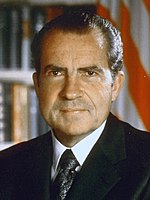The 1968 United States presidential election in the District of Columbia took place on November 5, 1968, as part of the 1968 United States presidential election. District of Columbia voters chose three representatives, or electors, to the Electoral College, who voted for president and vice president.[1]
| ||||||||||||||||||||||||||
| ||||||||||||||||||||||||||
 Ward Results
Humphrey 50-60% 70-80% 80-90% 90-100%
| ||||||||||||||||||||||||||
| ||||||||||||||||||||||||||
Vice President Hubert Humphrey won Washington, D.C. by an overwhelming margin, receiving over 80% of the vote.
This was the second presidential election in which the District of Columbia had the right to vote in presidential elections, as well as the only place where George Wallace did not have his name on the ballot. This remains the only presidential election in which the Republican nominee received a higher percentage of the vote in DC than at least one state in that same election as Nixon performed 5% better in Washington, D.C. than he did in both Mississippi and Alabama.
Campaign
editGeorge Wallace announced his intention to run under the American Independent Party at a press conference in Washington, D.C. on February 8, 1968.[2] Another event that happened also in the District was President Lyndon B. Johnson announcing from the Oval Office in the White House that he would not run for a second term on March 31.[3]
Results
edit| 1968 United States presidential election in the District of Columbia[1] | ||||||||
|---|---|---|---|---|---|---|---|---|
| Party | Candidate | Running mate | Popular vote | Electoral vote | ||||
| Count | % | Count | % | |||||
| Democratic | Hubert Humphrey of Minnesota | Edmund Muskie of Maine | 139,566 | 81.82% | 3 | 100.00% | ||
| Republican | Richard Nixon of New York | Spiro Agnew of Maryland | 31,012 | 18.18% | 0 | 0.00% | ||
| Total | 170,578 | 100.00% | 3 | 100.00% | ||||
See also
editNotes
edit- ^ Although he was born in California and he served as a U.S. Senator from California, in 1968 Richard Nixon's official state of residence was New York, because he moved there to practice law after his defeat in the 1962 California gubernatorial election. During his first term as president, Nixon re-established his residency in California. Consequently, most reliable reference books list Nixon's home state as New York in the 1968 election and his home state as California in the 1972 (and 1960) election.
References
edit- ^ a b "1968 Presidential Election Results Washington, D.C." Dave Leip's Atlas of U.S. Presidential Elections.
- ^ Rasberry, Robert W. (1969). THE "PUBLIC IMAGE" OF GEORGE WALLACE IN THE 1968 PRESIDENTIAL, ELECTION (PDF) (Thesis). North Texas State University. pp. 77 & 78.
- ^ Elving, Ron (July 29, 2024). "Biden's withdrawal from the race has echoes of LBJ". NPR (Digital). Retrieved July 30, 2024.
LBJ made his stunning announcement in an Oval Office address during prime time on the night of March 31, 1968.

